1-Year Mortality Prediction through Artificial Intelligence Using Hemodynamic Trace Analysis among Patients with ST Elevation Myocardial Infarction
Abstract
1. Introduction
2. Materials and Methods
2.1. Study Population and Data Acquisition
2.2. Statistical Analysis
2.3. Pre-Processing and Denoising of Data
- Mean values: Each window was segmented into three equal parts. For each segment, the mean value of the AP signal was calculated, resulting in three values.
- SD analysis: This involves calculating four SD values. The SD was computed for the entire window, and then the window was divided into three equal parts to determine the SD for each segment.
- FD Calculation: Each window was divided into three segments, and the FD was computed for each segment.
2.4. Feature Extraction
2.5. Feature Selection
2.5.1. LDA-Based Feature Selection (LBFS)
2.5.2. PCA-Based Feature Selection (PBFS)
2.6. Data Imbalance and Separation of Data into Training and Testing
2.7. ML Predictive Models
2.8. Models’ Evaluation
3. Results
3.1. Patients’ Characteristics
3.2. Denoised AP Signal
3.3. Extracted Features
3.4. Feature Selection Results
3.4.1. LBFS
3.4.2. PBFS
3.5. Results on ML Models (Hemodynamic Trace Features)
3.6. Results from ML Models (Adding Demographics, Risk Factors, and Catheterization Data)
4. Discussion
5. Conclusions
Author Contributions
Funding
Institutional Review Board Statement
Informed Consent Statement
Data Availability Statement
Conflicts of Interest
References
- Kasim, S.; Malek, S.; Aziz, M.F.; Ibrahim, K.S. Machine Learning to Predict In-Hospital Mortality Risk among Heterogenous STEMI Patients with Diabetes. Eur. Heart J. 2022, 43, ehab849-176. [Google Scholar] [CrossRef]
- Shah, B.R.; Hux, J.E.; Zinman, B. Increasing Rates of Ischemic Heart Disease in the Native Population of Ontario, Canada. Arch. Intern. Med. 2000, 160, 1862–1866. [Google Scholar] [CrossRef] [PubMed]
- Nicholas, M.; Townsend, N.; Scarborough, P.; Rayner, M. Cardiovascular Disease in Europe 2014: Epidemiological Update. Eur. Heart J. 2014, 35, 2950–2959, Erratum in Eur. Heart J. 2015, 36, 794. [Google Scholar] [CrossRef] [PubMed]
- CANSIM-102-0561—Leading Causes of Death, Total Population, by Age Group and Sex, Canada. Available online: https://www150.statcan.gc.ca/t1/tbl1/en/tv.action?pid=1310039401 (accessed on 31 March 2023).
- Bishu, K.G.; Lekoubou, A.; Kirkland, E.; Schumann, S.O.; Schreiner, A.; Heincelman, M.; Moran, W.P.; Mauldin, P.D. Estimating the Economic Burden of Acute Myocardial Infarction in the US: 12 Year National Data. Am. J. Med. Sci. 2020, 359, 257–265. [Google Scholar] [CrossRef]
- Vogel, B.; Claessen, B.E.; Arnold, S.V.; Chan, D.; Cohen, D.J.; Giannitsis, E.; Gibson, C.M.; Goto, S.; Katus, H.A.; Kerneis, M.; et al. ST-Segment Elevation Myocardial Infarction. Nat. Rev. Dis. Prim. 2019, 5, 39. [Google Scholar] [CrossRef]
- Wang, Y.; Jiang, Y.; Zhi, W.; Fu, Y.; Wang, Q.; Zhou, J.; Zheng, S.; Hao, G. Safety and Feasibility of Low-Dose Ticagrelor in Patients with ST-Segment Elevation Myocardial Infarction. Clin. Cardiol. 2021, 44, 123–128. [Google Scholar] [CrossRef]
- Mensah, G.A.; Wei, G.S.; Sorlie, P.D.; Fine, L.J.; Rosenberg, Y.; Kaufmann, P.G.; Mussolino, M.E.; Hsu, L.L.; Addou, E.; Engelgau, M.M.; et al. Decline in Cardiovascular Mortality. Circ. Res. 2017, 120, 366–380. [Google Scholar] [CrossRef] [PubMed]
- de Boer, S.P.M.; Westerhout, C.M.; Simes, R.J.; Granger, C.B.; Zijlstra, F.; Boersma, E. Mortality and Morbidity Reduction by Primary Percutaneous Coronary Intervention Is Independent of the Patient’s Age. JACC Cardiovasc. Interv. 2010, 3, 324–331. [Google Scholar] [CrossRef]
- OECD/European Union (2020). Health at a Glance: Europe 2020; Health at a Glance: Europe; OECD: Paris, France, 2020; ISBN 9789264365643. [Google Scholar]
- Thrane, P.G.; Olesen, K.K.W.; Thim, T.; Gyldenkerne, C.; Mortensen, M.B.; Kristensen, S.D.; Maeng, M. Mortality Trends After Primary Percutaneous Coronary Intervention for ST-Segment Elevation Myocardial Infarction. J. Am. Coll. Cardiol. 2023, 82, 999–1010. [Google Scholar] [CrossRef]
- Kandala, J.; Oommen, C.; Kern, K.B. Sudden Cardiac Death. Br. Med. Bull. 2017, 122, 5–15. [Google Scholar] [CrossRef]
- Elbadawi, A.; Elgendy, I.Y.; Mahmoud, K.; Barakat, A.F.; Mentias, A.; Mohamed, A.H.; Ogunbayo, G.O.; Megaly, M.; Saad, M.; Omer, M.A.; et al. Temporal Trends and Outcomes of Mechanical Complications in Patients With Acute Myocardial Infarction. JACC Cardiovasc. Interv. 2019, 12, 1825–1836. [Google Scholar] [CrossRef] [PubMed]
- Mohebbi, B. ST-Segment Elevation Myocardial Infarction. In Practical Cardiology: Principles and Approaches; Elsevier: Amsterdam, The Netherlands, 2022; ISBN 9780323809153. [Google Scholar]
- Fox, K.A.; Dabbous, O.H.; Goldberg, R.J.; Pieper, K.S.; Eagle, K.A.; Van de Werf, F.; Avezum, Á.; Goodman, S.G.; Flather, M.D.; Anderson, F.A.; et al. Prediction of Risk of Death and Myocardial Infarction in the Six Months after Presentation with Acute Coronary Syndrome: Prospective Multinational Observational Study (GRACE). Br. Med. J. 2006, 333, 1091. [Google Scholar] [CrossRef] [PubMed]
- Ibanez, B.; James, S.; Agewall, S.; Antunes, M.J.; Bucciarelli-Ducci, C.; Bueno, H.; Caforio, A.L.P.; Crea, F.; Goudevenos, J.A.; Halvorsen, S.; et al. 2017 ESC Guidelines for the Management of Acute Myocardial Infarction in Patients Presenting with ST-Segment Elevation. Kardiol. Pol. 2018, 76, 229–313. [Google Scholar] [CrossRef] [PubMed]
- Morrow, D.A.; Antman, E.M.; Charlesworth, A.; Cairns, R.; Murphy, S.A.; de Lemos, J.A.; Giugliano, R.P.; McCabe, C.H.; Braunwald, E. TIMI Risk Score for ST-Elevation Myocardial Infarction: A Convenient, Bedside, Clinical Score for Risk Assessment at Presentation. Circulation 2000, 102, 2031–2037. [Google Scholar] [CrossRef] [PubMed]
- Morrow, D.A.; Antman, E.M.; Parsons, L.; De Lemos, J.A.; Cannon, C.P.; Giugliano, R.P.; McCabe, C.H.; Barron, H.V.; Braunwald, E. Application of the TIMI Risk Score for ST-Elevation MI in the National Registry of Myocardial Infarction 3. JAMA 2001, 286, 1356–1359. [Google Scholar] [CrossRef] [PubMed]
- Scruth, E.A.; Cheng, E.; Worrall-Carter, L. Risk Score Comparison of Outcomes in Patients Presenting with ST-Elevation Myocardial Infarction Treated with Percutaneous Coronary Intervention. Eur. J. Cardiovasc. Nurs. 2013, 12, 330–336. [Google Scholar] [CrossRef] [PubMed]
- Halkin, A.; Singh, M.; Nikolsky, E.; Grines, C.L.; Tcheng, J.E.; Garcia, E.; Cox, D.A.; Turco, M.; Stuckey, T.D.; Na, Y.; et al. Prediction of Mortality after Primary Percutaneous Coronary Intervention for Acute Myocardial Infarction: The CADILLAC Risk Score. J. Am. Coll. Cardiol. 2005, 45, 1397–1405. [Google Scholar] [CrossRef] [PubMed]
- De Luca, G.; Suryapranata, H.; Van’t Hof, A.W.J.; De Boer, M.J.; Hoorntje, J.C.A.; Dambrink, J.H.E.; Gosselink, A.T.M.; Ottervanger, J.P.; Zijlstra, F. Prognostic Assessment of Patients with Acute Myocardial Infarction Treated with Primary Angioplasty: Implications for Early Discharge. Circulation 2004, 109, 2737–2743. [Google Scholar] [CrossRef] [PubMed]
- Collet, J.P.; Thiele, H.; Barbato, E.; Bauersachs, J.; Dendale, P.; Edvardsen, T.; Gale, C.P.; Jobs, A.; Lambrinou, E.; Mehilli, J.; et al. 2020 ESC Guidelines for the Management of Acute Coronary Syndromes in Patients Presenting without Persistent ST-Segment Elevation. Eur. Heart J. 2021, 42, 1289–1367. [Google Scholar] [CrossRef] [PubMed]
- Kwon, J.M.; Jeon, K.H.; Kim, H.M.; Kim, M.J.; Lim, S.; Kim, K.H.; Song, P.S.; Park, J.; Choi, R.K.; Oh, B.-H.; et al. Deep-Learning-Based out-of-Hospital Cardiac Arrest Prognostic System to Predict Clinical Outcomes. Resuscitation 2019, 139, 84–91. [Google Scholar] [CrossRef]
- Hametner, B.; Wassertheurer, S.; Mayer, C.C.; Danninger, K.; Binder, R.K.; Weber, T. Aortic Pulse Wave Velocity Predicts Cardiovascular Events and Mortality in Patients Undergoing Coronary Angiography. Hypertension 2021, 77, 571–581. [Google Scholar] [CrossRef] [PubMed]
- Blacher, J.; Asmar, R.; Djane, S.; London, G.M.; Safar, M.E. Aortic Pulse Wave Velocity as a Marker of Cardiovascular Risk in Hypertensive Patients. Hypertension 1999, 33, 1111–1117. [Google Scholar] [CrossRef] [PubMed]
- D’Ascenzo, F.; De Filippo, O.; Gallone, G.; Mittone, G.; Deriu, M.A.; Iannaccone, M.; Ariza-Solé, A.; Liebetrau, C.; Manzano-Fernández, S.; Quadri, G.; et al. Machine Learning-Based Prediction of Adverse Events Following an Acute Coronary Syndrome (PRAISE): A Modelling Study of Pooled Datasets. Lancet 2021, 397, 199–207. [Google Scholar] [CrossRef] [PubMed]
- Oliveira, M.; Seringa, J.; Pinto, F.J.; Henriques, R.; Magalhães, T. Machine Learning Prediction of Mortality in Acute Myocardial Infarction. BMC Med. Inform. Decis. Mak. 2023, 23, 70. [Google Scholar] [CrossRef] [PubMed]
- Shetty, M.K.; Kunal, S.; Girish, M.P.; Qamar, A.; Arora, S.; Hendrickson, M.; Mohanan, P.P.; Gupta, P.; Ramakrishnan, S.; Yadav, R.; et al. Machine Learning Based Model for Risk Prediction after ST-Elevation Myocardial Infarction: Insights from the North India ST Elevation Myocardial Infarction (NORIN-STEMI) Registry. Int. J. Cardiol. 2022, 362, 6–13. [Google Scholar] [CrossRef] [PubMed]
- Aziz, F.; Malek, S.; Ibrahim, K.S.; Shariff, R.E.R.; Wan Ahmad, W.A.; Ali, R.M.; Liu, K.T.; Selvaraj, G.; Kasim, S. Short- and Long-Term Mortality Prediction after an Acute ST-Elevation Myocardial Infarction (STEMI) in Asians: A Machine Learning Approach. PLoS ONE 2021, 16, e0254894. [Google Scholar] [CrossRef] [PubMed]
- Wang, S.; Li, J.; Sun, L.; Cai, J.; Wang, S.; Zeng, L.; Sun, S. Application of Machine Learning to Predict the Occurrence of Arrhythmia after Acute Myocardial Infarction. BMC Med. Inform. Decis. Mak. 2021, 21, 301. [Google Scholar] [CrossRef] [PubMed]
- Zhang, Z.; Qiu, H.; Li, W.; Chen, Y. A Stacking-Based Model for Predicting 30-Day All-Cause Hospital Readmissions of Patients with Acute Myocardial Infarction. BMC Med. Inform. Decis. Mak. 2020, 20, 335. [Google Scholar] [CrossRef]
- Sherazi, S.W.A.; Jeong, Y.J.; Jae, M.H.; Bae, J.W.; Lee, J.Y. A Machine Learning–Based 1-Year Mortality Prediction Model after Hospital Discharge for Clinical Patients with Acute Coronary Syndrome. Health Inform. J. 2020, 26, 1289–1304. [Google Scholar] [CrossRef]
- Kasim, S.; Malek, S.; Ibrahim, K.K.; Aziz, M. Risk Stratification of Asian Patients after ST-Elevation Myocardial Infarction Using Machine Learning Methods. Eur. Heart J. 2020, 41, ehaa946-3494. [Google Scholar] [CrossRef]
- Li, Y.M.; Jiang, L.C.; He, J.J.; Jia, K.Y.; Peng, Y.; Chen, M. Machine Learning to Predict the 1-Year Mortality Rate after Acute Anterior Myocardial Infarction in Chinese Patients. Ther. Clin. Risk Manag. 2020, 16, 1–6. [Google Scholar] [CrossRef] [PubMed]
- Hadanny, A.; Shouval, R.; Wu, J.; Shlomo, N.; Unger, R.; Zahger, D.; Matetzky, S.; Goldenberg, I.; Beigel, R.; Gale, C.; et al. Predicting 30-Day Mortality after ST Elevation Myocardial Infarction: Machine Learning- Based Random Forest and Its External Validation Using Two Independent Nationwide Datasets. J. Cardiol. 2021, 78, 439–446. [Google Scholar] [CrossRef] [PubMed]
- Bai, Z.; Lu, J.; Li, T.; Ma, Y.; Liu, Z.; Zhao, R.; Wang, Z.; Shi, B. Clinical Feature-Based Machine Learning Model for 1-Year Mortality Risk Prediction of ST-Segment Elevation Myocardial Infarction in Patients with Hyperuricemia: A Retrospective Study. Comput. Math. Methods Med. 2021, 2021, 7252280. [Google Scholar] [CrossRef] [PubMed]
- Cohen, J. Statistical Power Analysis for the Behavioural Sciences, 2nd ed.; Routledge: London, UK, 1988. [Google Scholar]
- Pan, J.; Tompkins, W.J. A Real-Time QRS Detection Algorithm. IEEE Trans. Biomed. Eng. 1985, 32, 230–236. [Google Scholar] [CrossRef] [PubMed]
- Katz, M.J. Fractals and the Analysis of Waveforms. Comput. Biol. Med. 1988, 18, 145–156. [Google Scholar] [CrossRef] [PubMed]
- Abdi, H.; Williams, L.J. Principal Component Analysis. Wiley Interdiscip. Rev. Comput. Stat. 2010, 2, 433–459. [Google Scholar] [CrossRef]
- Xanthopoulos, P.; Pardalos, P.M.; Trafalis, T.B. Linear Discriminant Analysis. In Robust Data Mining; Springer: Berlin/Heidelberg, Germany, 2013. [Google Scholar]
- Wei, Q.; Dunbrack, R.L. The Role of Balanced Training and Testing Data Sets for Binary Classifiers in Bioinformatics. PLoS ONE 2013, 8, e67863. [Google Scholar] [CrossRef] [PubMed]
- Cover, T.M.; Hart, P.E. Nearest Neighbor Pattern Classification. IEEE Trans. Inf. Theory 1967, 13, 21–27. [Google Scholar] [CrossRef]
- Burges, C.J.C. A Tutorial on Support Vector Machines for Pattern Recognition. Data Min. Knowl. Discov. 1998, 2, 121–167. [Google Scholar] [CrossRef]
- Subasi, A.; Gursoy, M.I. EEG Signal Classification Using PCA, ICA, LDA and Support Vector Machines. Expert Syst. Appl. 2010, 37, 8659–8666. [Google Scholar] [CrossRef]
- Raghavendra, B.S.; Dutt, D.N. Signal Characterization Using Fractal Dimension. Fractals 2010, 18, 287–292. [Google Scholar] [CrossRef]
- Tripathy, R.K.; Bhattacharyya, A.; Pachori, R.B. A Novel Approach for Detection of Myocardial Infarction from ECG Signals of Multiple Electrodes. IEEE Sens. J. 2019, 19, 4509–4517. [Google Scholar] [CrossRef]
- Zheng, Y.Y.; Wu, T.T.; Chen, Y.; Hou, X.G.; Yang, Y.; Ma, X.; Ma, Y.T.; Zhang, J.Y.; Xie, X. Resting Heart Rate and Long-Term Outcomes in Patients with Percutaneous Coronary Intervention: Results from a 10-Year Follow-Up of the CORFCHD-PCI Study. Cardiol. Res. Pract. 2019, 2019, 5432076. [Google Scholar] [CrossRef]
- Lahti, R.; Rankinen, J.; Lyytikäinen, L.P.; Eskola, M.; Nikus, K.; Hernesniemi, J. High-Risk ECG Patterns in ST Elevation Myocardial Infarction for Mortality Prediction. J. Electrocardiol. 2022, 74, 13–19. [Google Scholar] [CrossRef]
- Cymberknop, L.; Legnani, W.; Pessana, F.; Bia, D.; Zócalo, Y.; Armentano, R.L. Stiffness Indices and Fractal Dimension Relationship in Arterial Pressure and Diameter Time Series In-Vitro. J. Phys. Conf. Ser. 2011, 332, 012024. [Google Scholar] [CrossRef]
- Lehmann, E.D.; Hopkins, K.D.; Rawesh, A.; Joseph, R.C.; Kongola, K.; Coppack, S.W.; Gosling, R.G. Relation between Number of Cardiovascular Risk Factors/Events and Noninvasive Doppler Ultrasound Assessments of Aortic Compliance. Hypertension 1998, 32, 565–569. [Google Scholar] [CrossRef]
- Reant, P.; Dijos, M.; Donal, E.; Mignot, A.; Ritter, P.; Bordachar, P.; Dos Santos, P.; Leclercq, C.; Roudaut, R.; Habib, G.; et al. Systolic Time Intervals as Simple Echocardiographic Parameters of Left Ventricular Systolic Performance: Correlation with Ejection Fraction and Longitudinal Two-Dimensional Strain. Eur. J. Echocardiogr. 2010, 11, 834–844. [Google Scholar] [CrossRef]
- Patel, P.A.; Ambrosy, A.P.; Phelan, M.; Alenezi, F.; Chiswell, K.; Van Dyke, M.K.; Tomfohr, J.; Honarpour, N.; Velazquez, E.J. Association between Systolic Ejection Time and Outcomes in Heart Failure by Ejection Fraction. Eur. J. Heart Fail. 2020, 22, 1174–1182. [Google Scholar] [CrossRef]
- Said, S.; Hernandez, G.T. The Link between Chronic Kidney Disease and Cardiovascular Disease. J. Nephropathol. 2014, 3, 99–104. [Google Scholar] [CrossRef]
- Alkhalil, M.; McCune, C.; McClenaghan, L.; Mailey, J.; Collins, P.; Kearney, A.; Todd, M.; McKavanagh, P. Comparative Analysis of the Effect of Renal Function on the Spectrum of Coronary Artery Disease. Am. J. Med. 2020, 133, e631–e640. [Google Scholar] [CrossRef]
- Al’Aref, S.J.; Singh, G.; van Rosendael, A.R.; Kolli, K.K.; Ma, X.; Maliakal, G.; Pandey, M.; Lee, B.C.; Wang, J.; Xu, Z.; et al. Determinants of In-Hospital Mortality After Percutaneous Coronary Intervention: A Machine Learning Approach. J. Am. Heart Assoc. 2019, 8, e011160. [Google Scholar] [CrossRef] [PubMed]
- Lee, H.C.; Park, J.S.; Choe, J.C.; Ahn, J.H.; Lee, H.W.; Oh, J.H.; Choi, J.H.; Cha, K.S.; Hong, T.J.; Jeong, M.H. Prediction of 1-Year Mortality from Acute Myocardial Infarction Using Machine Learning. Am. J. Cardiol. 2020, 133, 23–31. [Google Scholar] [CrossRef] [PubMed]
- Weichwald, S.; Candreva, A.; Burkholz, R.; Klingenberg, R.; Räber, L.; Heg, D.; Manka, R.; Gencer, B.; Mach, F.; Nanchen, D.; et al. Improving 1-Year Mortality Prediction in ACS Patients Using Machine Learning. Eur. Heart J. Acute Cardiovasc. Care 2021, 10, 855–865. [Google Scholar] [CrossRef] [PubMed]
- Hizoh, I.; Domokos, D.; Banhegyi, G.; Becker, D.; Merkely, B.; Ruzsa, Z. Mortality Prediction Algorithms for Patients Undergoing Primary Percutaneous Coronary Intervention. J. Thorac. Dis. 2020, 12, 1706–1720. [Google Scholar] [CrossRef] [PubMed]
- Ke, J.; Chen, Y.; Wang, X.; Wu, Z.; Zhang, Q.; Lian, Y.; Chen, F. Machine Learning-Based in-Hospital Mortality Prediction Models for Patients with Acute Coronary Syndrome. Am. J. Emerg. Med. 2022, 53, 127–134. [Google Scholar] [CrossRef]
- Lee, W.; Lee, J.; Woo, S.I.; Choi, S.H.; Bae, J.W.; Jung, S.; Jeong, M.H.; Lee, W.K. Machine Learning Enhances the Performance of Short and Long-Term Mortality Prediction Model in Non-ST-Segment Elevation Myocardial Infarction. Sci. Rep. 2021, 11, 12886. [Google Scholar] [CrossRef]
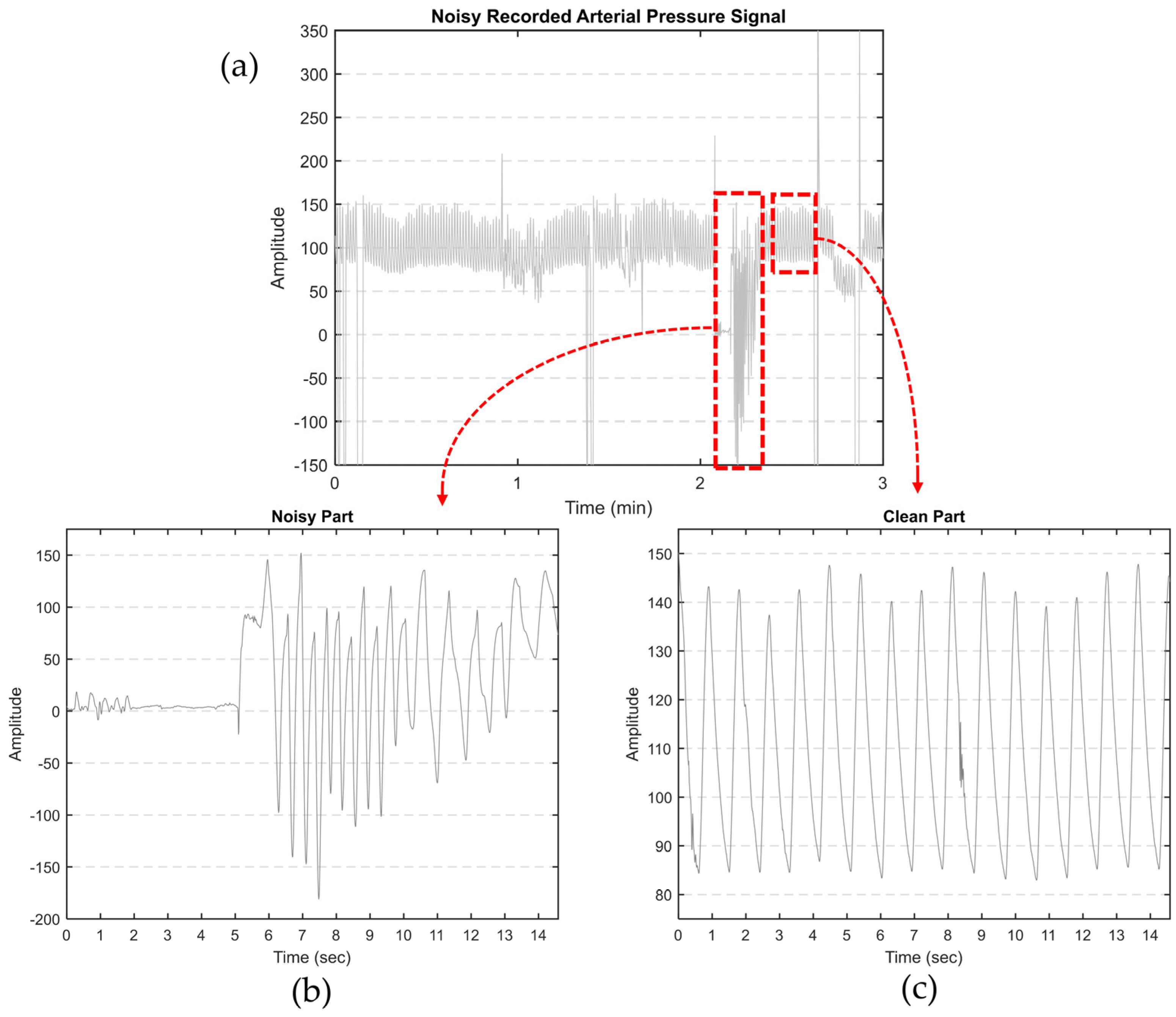
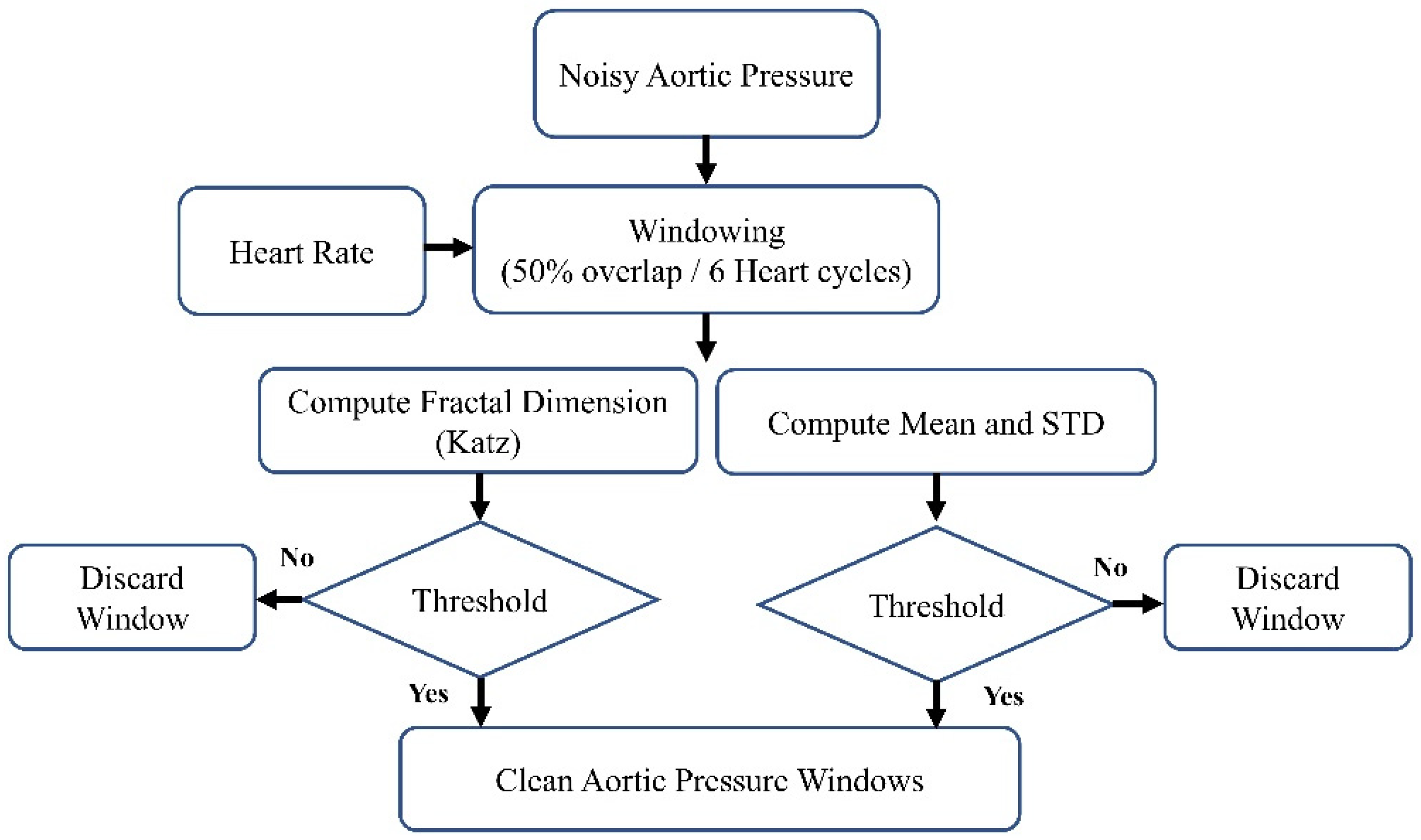

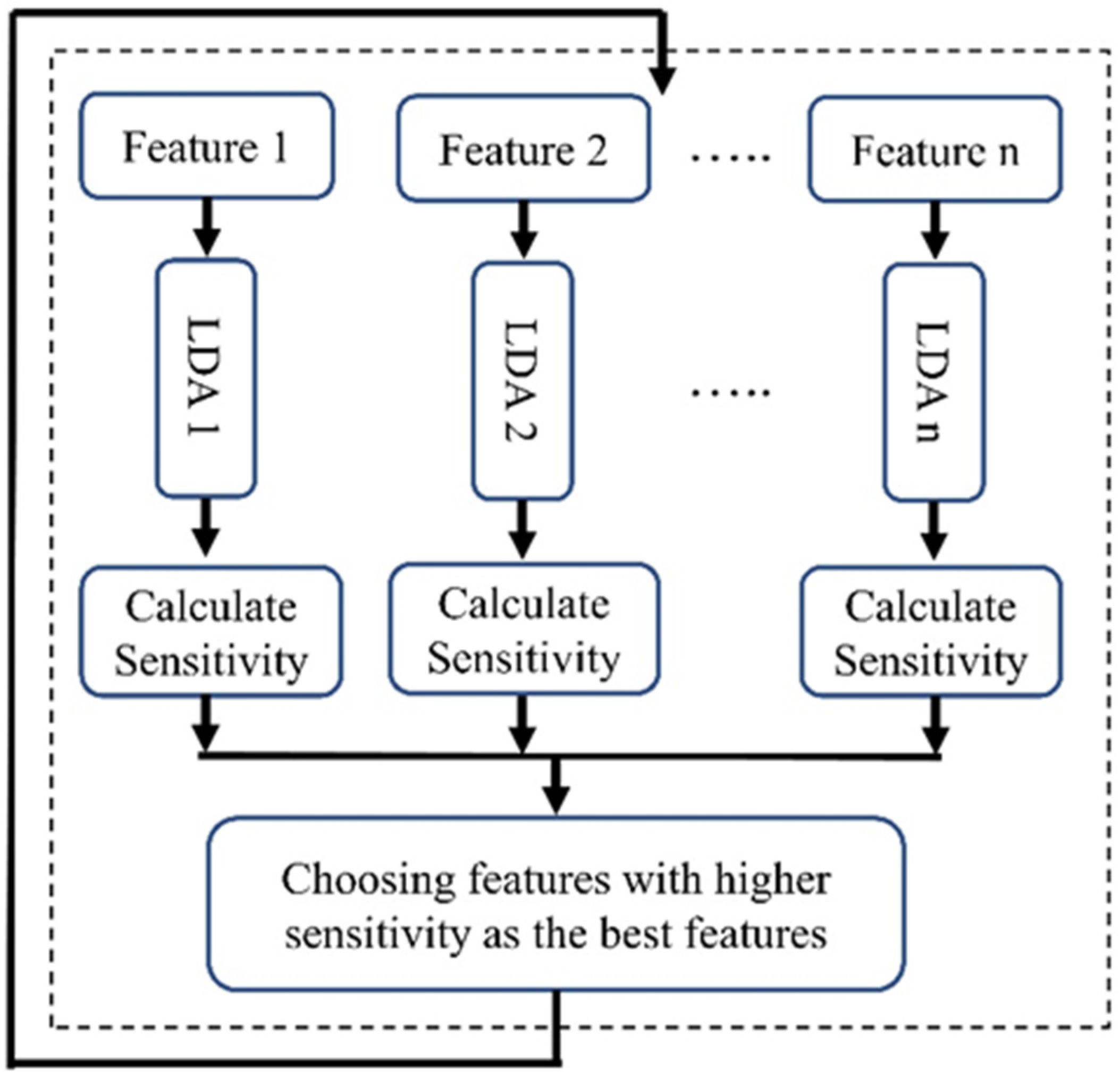
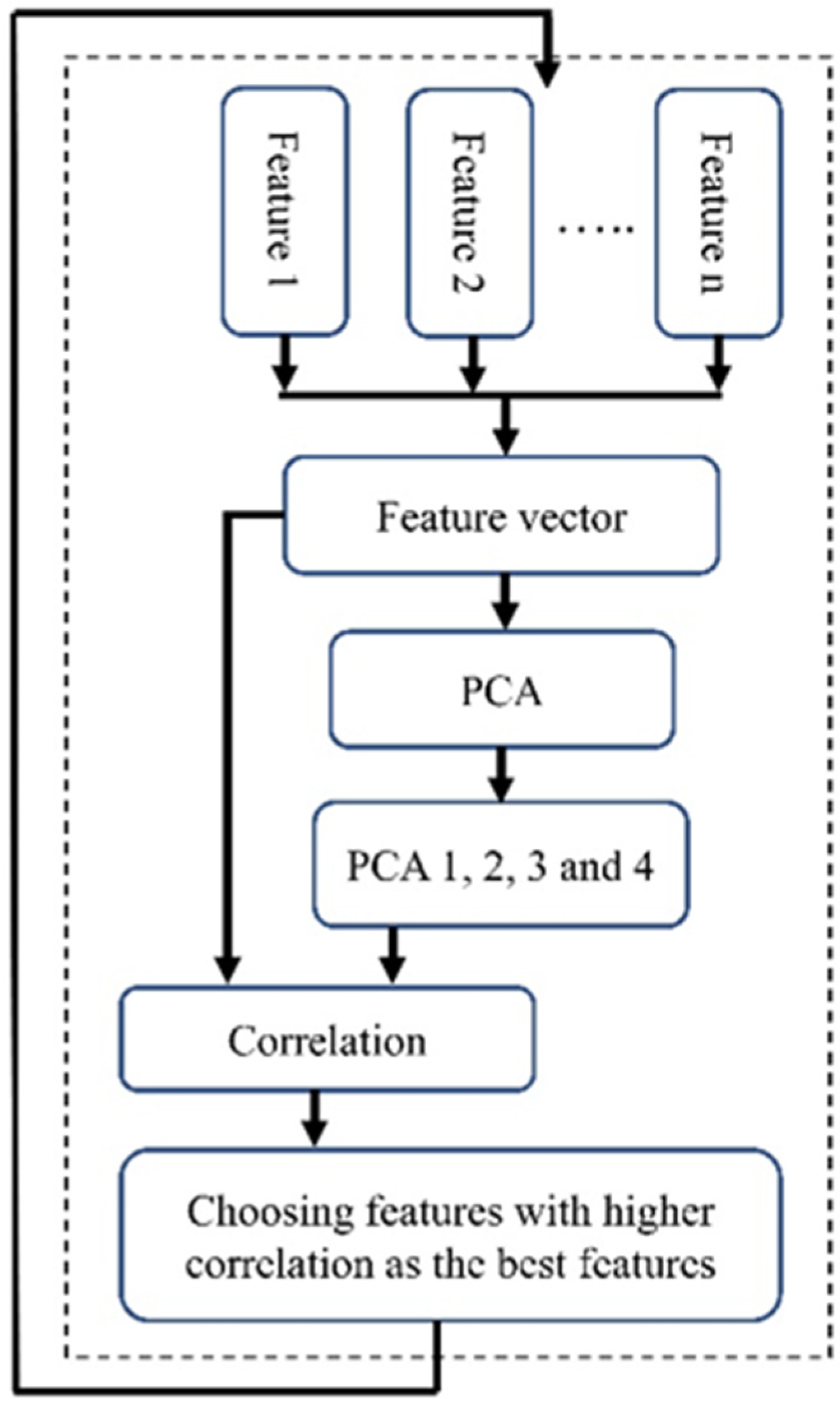
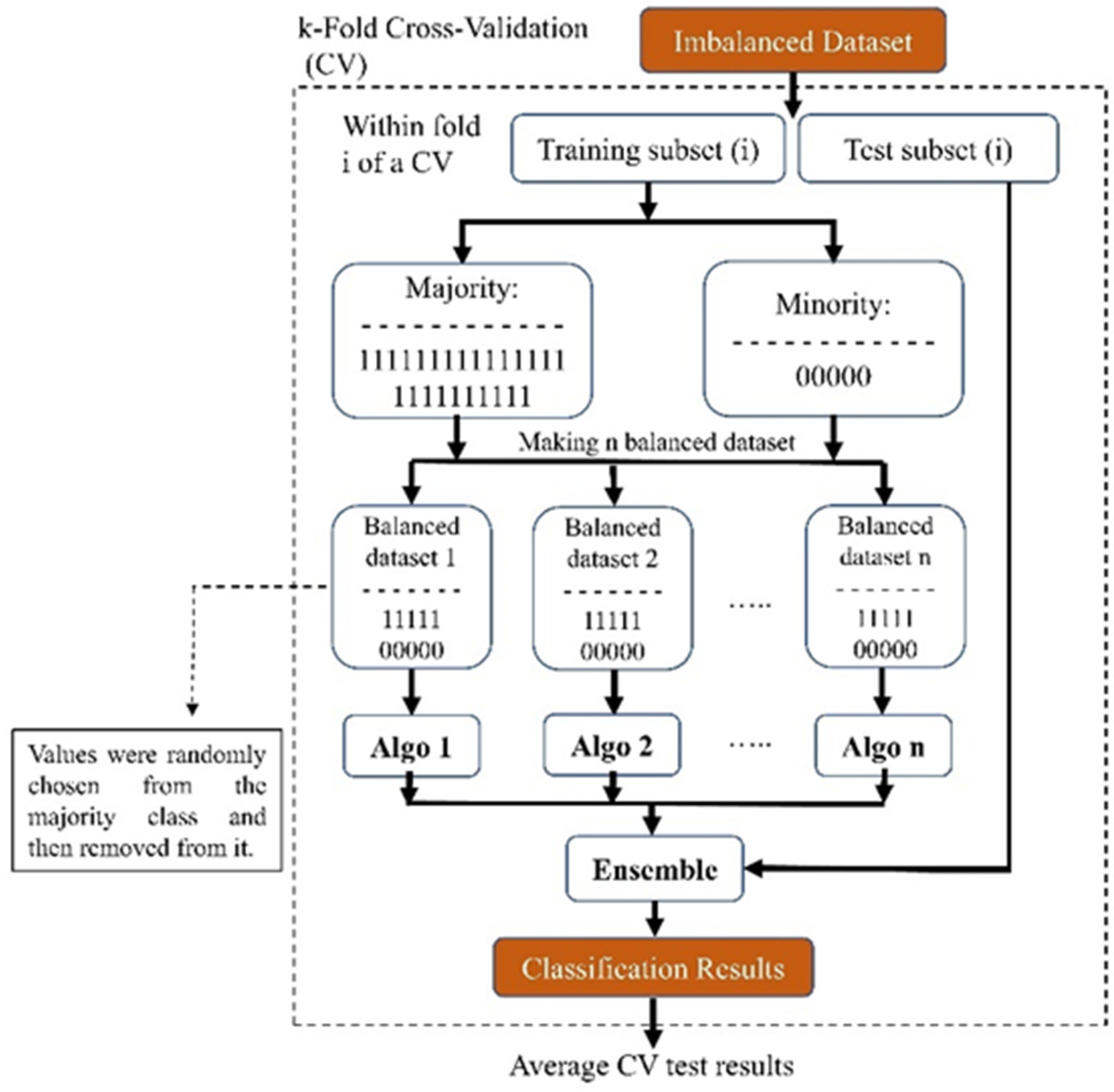
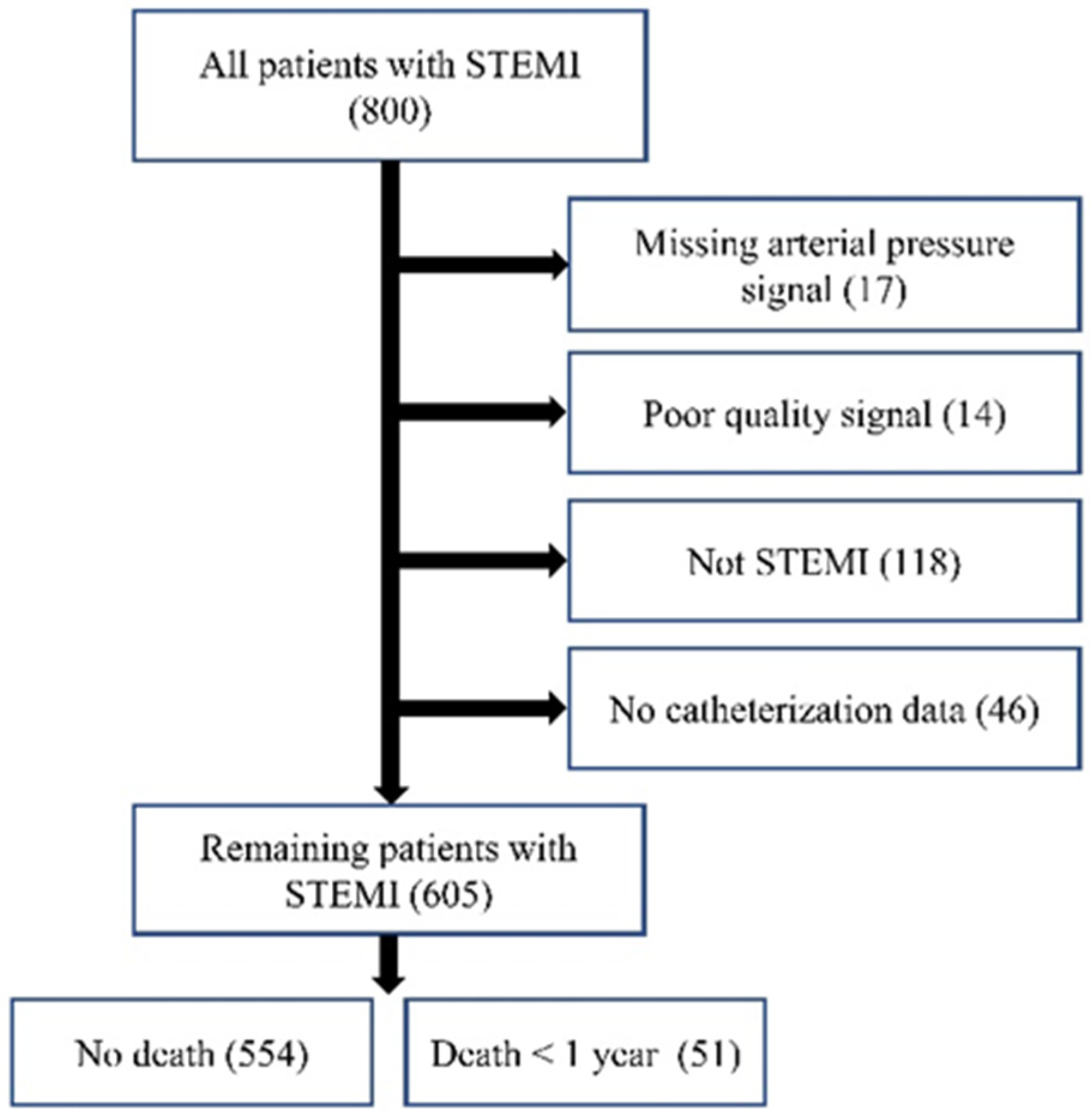
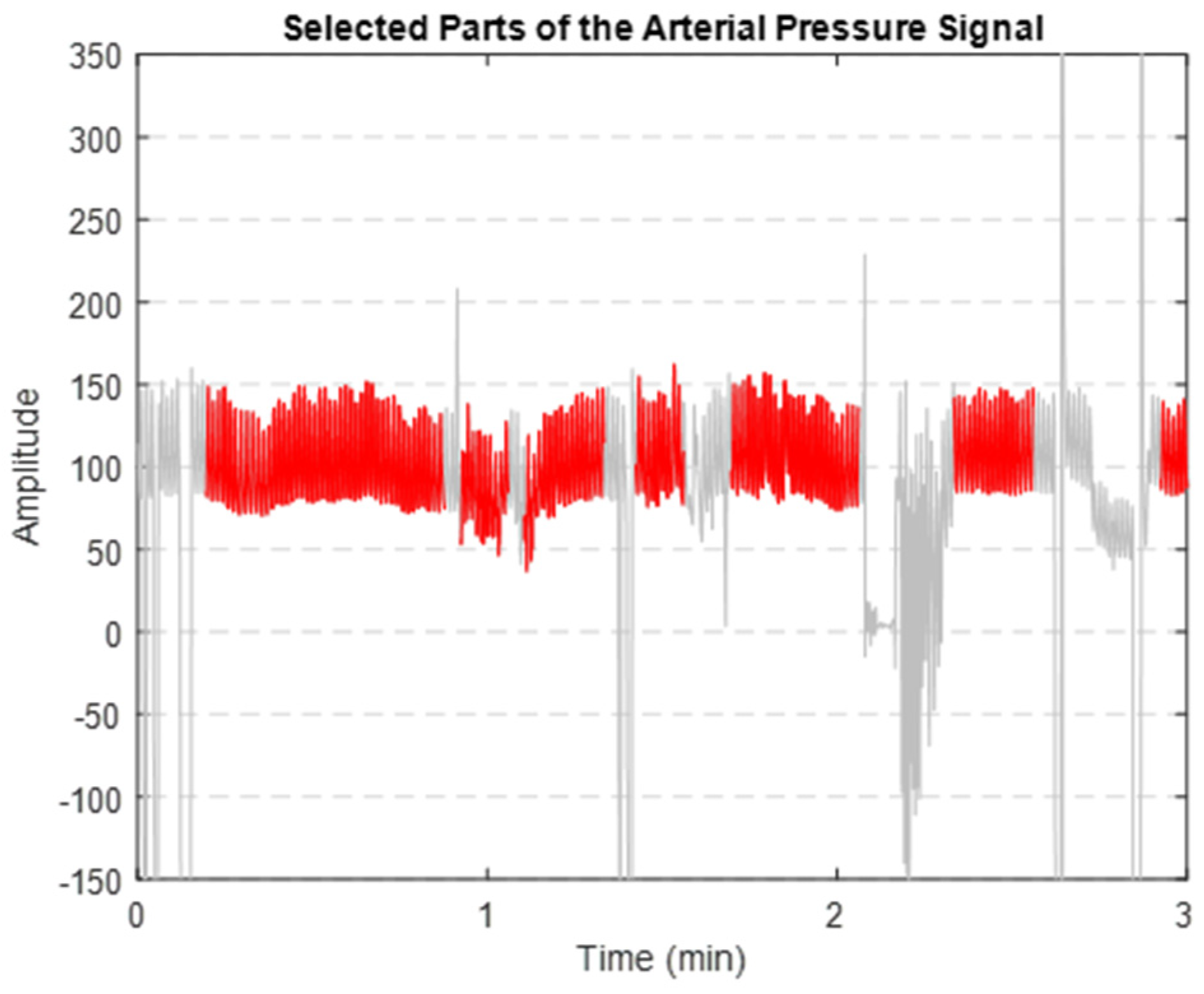
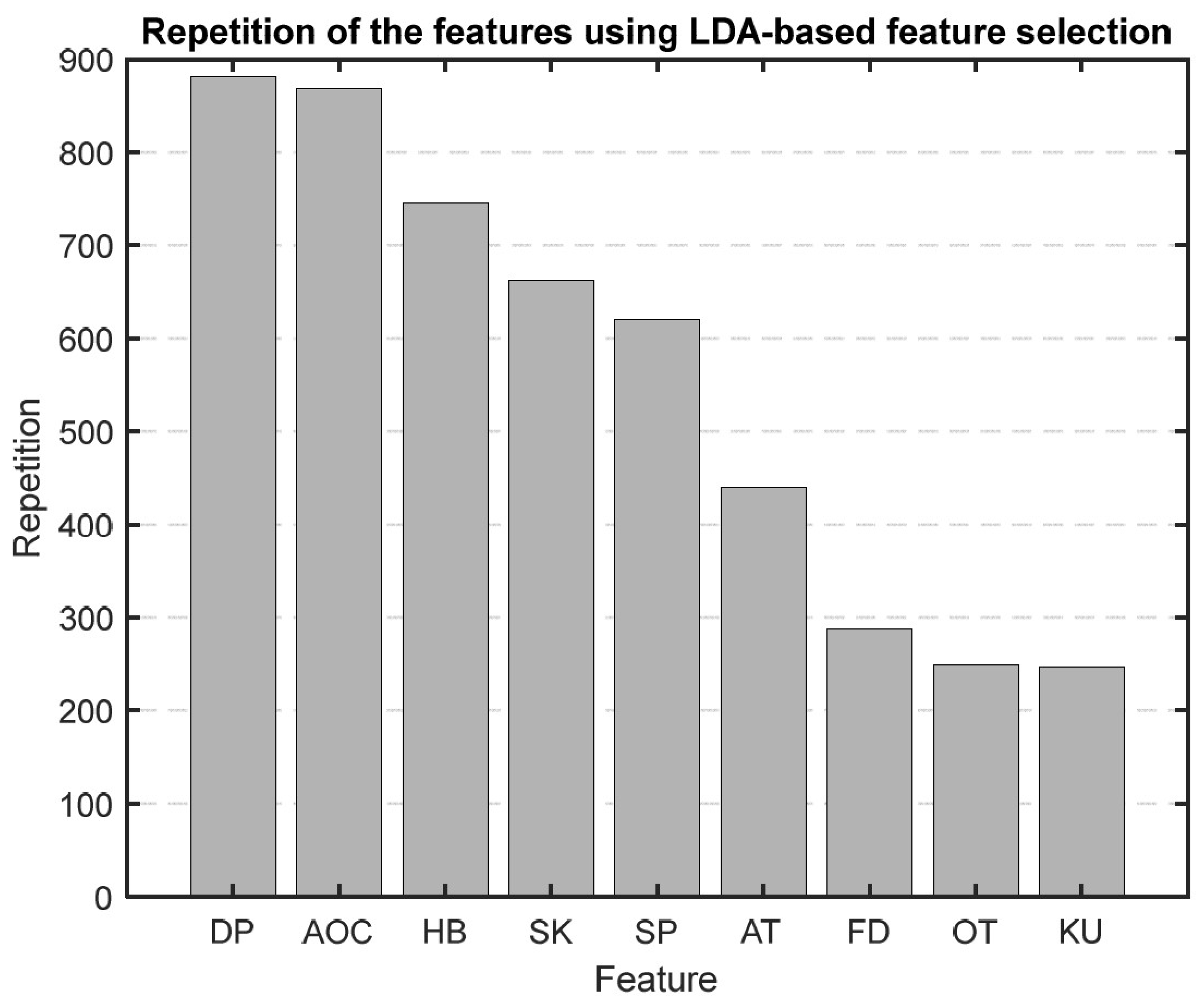
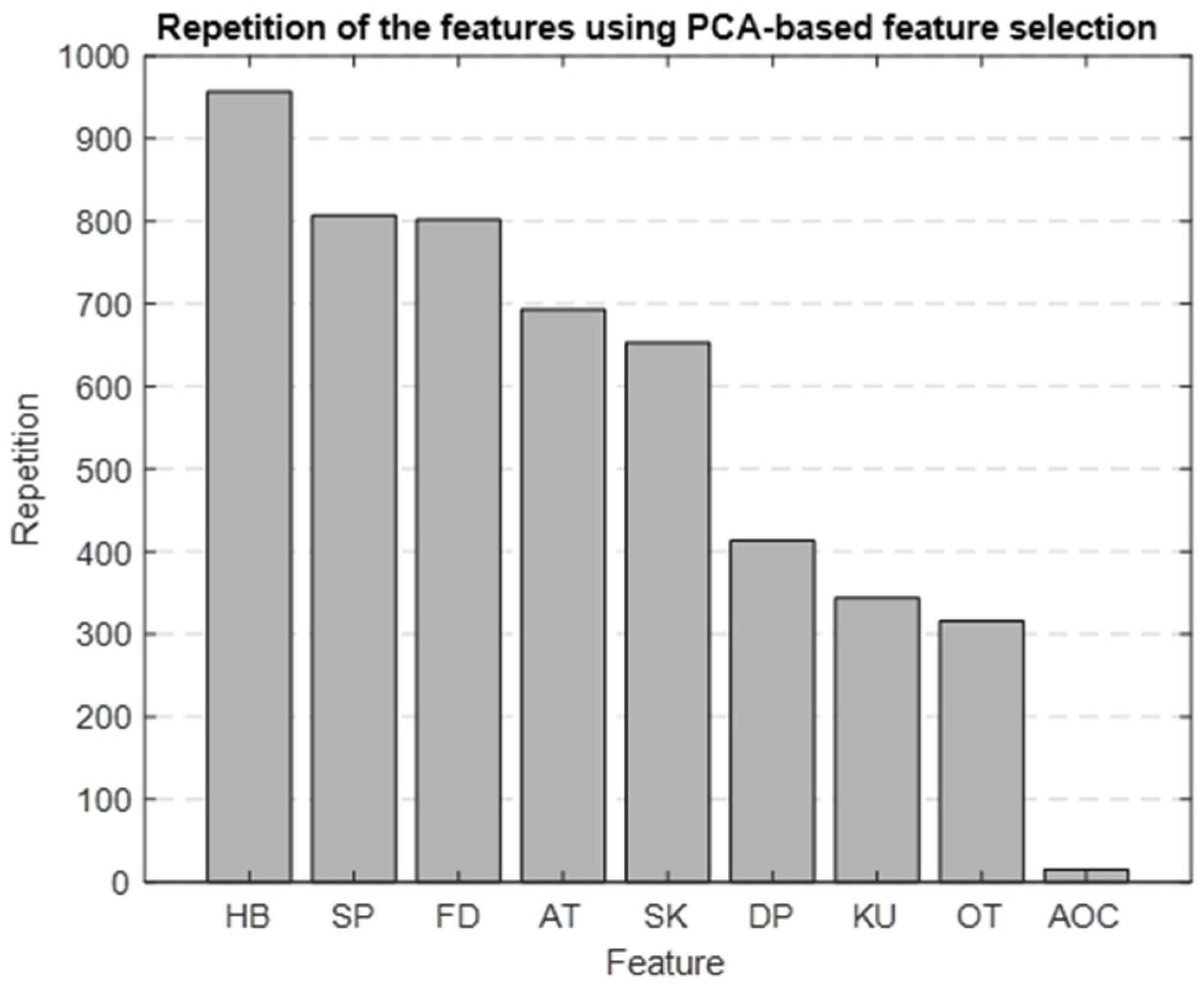

| Feature | Abbreviation | Definition | p-Value (Death < 1 Year vs. No Death) | |
|---|---|---|---|---|
| 1 | Heartbeat | HB | 60/(t @ end) | <0.01 |
| 2 | Diastolic blood pressure | DBP | ) | <0.01 |
| 3 | Systolic blood pressure | SBP | ) | <0.01 |
| 4 | Pulse pressure | PP | SBP—DBP | <0.01 |
| 5 | Mean arterial pressure | MAP | (2 × DBP + SBP/3 | <0.01 |
| 6 | Overall time | OT | Whole time of the surgery | <0.01 |
| 7 | Ascending time | AT | t @ systolic peak | <0.01 |
| 8 | Descending time | DT | (t @ end)—AT | <0.01 |
| 9 | Total area under the curve | AOC | <0.01 | |
| 10 | Ascending area | UA | <0.01 | |
| 11 | Descending area | DA | AOC—UA | <0.01 |
| 12 | Area Ratio | AR | DA/UA | <0.01 |
| 13 | Maximum slope | MS | <0.01 | |
| 14 | Fractal dimension | FD | Kats FD method | <0.01 |
| 15 | Skewness | SK | <0.01 | |
| 16 | Kurtosis | KU | <0.01 | |
| 17 | Spectral Entropy | SE | −Sum (PSD × log2(PSD)) | <0.01 |
| 18 | Average power | Pave | Sum (PSD)/n | <0.01 |
| Characteristics | Total | No. Death | Death < 1 Year | p-Value (Death < 1 Year vs. No. Death) | Effect Size |
|---|---|---|---|---|---|
| No. of Patients | 605 | 554 (91.57%) | 51 (8.43%) | ||
| Demographics | |||||
| Age, years | 64.19 ± 13.18 | 63.56 ± 12.10 | 70.96 ± 13.38 | <0.001 | 0.57 |
| Male, no. (%) | 432 (71.41%) | 405 (73.10%) | 27 (52.94%) | 0.007 | 0.13 |
| Weight, kg | 171.65 ± 10.76 | 171.93 ± 10.68 | 168.73 ± 11.27 | 0.016 | 0.30 |
| Height, cm | 85.64 ± 20.13 | 86.24 ± 19.99 | 79.15 ± 20.69 | 0.043 | 0.35 |
| BMI, kg/m2 | 29.14 ± 8.58 | 29.27 ± 8.76 | 27.7 ± 6.29 | 0.12 | 0.18 |
| Risk Factors, no. (%) | |||||
| Hypertension | 349 (57.67%) | 314 (56.68%) | 35 (68.63%) | 0.098 | 0.07 |
| DM | 156 (25.79%) | 139 (25.09%) | 17 (33.33%) | 0.19 | 0.05 |
| Dyslipidemia | 246 (40.66%) | 230 (41.52%) | 16 (31.37%) | 0.16 | 0.06 |
| Stroke or TIA | 28 (4.63%) | 21 (3.79%) | 7 (13.72%) | 0.001 | 0.13 |
| PVD | 19 (3.14%) | 15 (2.71%) | 4 (7.84%) | 0.044 | 0.08 |
| RD | 38 (6.28%) | 24 (4.33%) | 14 (27.45%) | <0.001 | 0.26 |
| Dialysis | 5 (0.83%) | 1 (0.18%) | 4 (7.84%) | <0.001 | 0.24 |
| History of IHD | 116 (19.17%) | 108 (19.49%) | 8 (15.68%) | 0.51 | 0.03 |
| PCI or CABG | 90 (14.88%) | 85 (15.34%) | 5 (9.8%) | 0.29 | 0.04 |
| Catheterization Data | |||||
| ESP, s/min | 19.11 ± 3.29 | 19.19 ± 3.23 | 18.31 ± 3.82 | 0.042 | 0.27 |
| EST, s/beat | 0.24 ± 0.04 | 0.24 ± 0.04 | 0.22 ± 0.05 | 0.002 | 0.46 |
| Feature | Abbreviation | Definition | p-Value (Death < 1 Year vs. No. Death) | |
|---|---|---|---|---|
| 1 | Heartbeat | HB | 60/(t @ end) | <0.001 |
| 2 | Diastolic blood pressure | DBP | ) | <0.001 |
| 3 | Systolic blood pressure | SBP | ) | <0.001 |
| 4 | Overall time | OT | Whole time of the surgery | <0.001 |
| 5 | Ascending time | AT | t @ systolic peak | <0.001 |
| 6 | Total area under the curve | AOC | <0.001 | |
| 7 | Fractal dimension | FD | Kats FD method | <0.001 |
| 8 | Skewness | SK | <0.001 | |
| 9 | Kurtosis | KU | <0.001 |
| PBFS | LBFS | |||||
|---|---|---|---|---|---|---|
| Classifier | KNN | LDA | SVM | KNN | LDA | SVM |
| Accuracy (%) | 70 | 71 | 70 | 69 | 72 | 72 |
| Specificity (%) | 70 | 71 | 70 | 69 | 72 | 73 |
| Sensitivity (%) | 69 | 70 | 72 | 73 | 73 | 68 |
| Precision (%) | 18 | 18 | 18 | 18 | 19 | 19 |
| AUC | 0.73 | 0.77 | 0.76 | 0.73 | 0.77 | 0.74 |
| PBFS | LBFS | |||||
|---|---|---|---|---|---|---|
| Classifier | KNN | LDA | SVM | KNN | LDA | SVM |
| Accuracy (%) | 78 | 78 | 77 | 79 | 76 | 77 |
| Specificity (%) | 79 | 80 | 77 | 80 | 76 | 78 |
| Sensitivity (%) | 73 | 71 | 73 | 71 | 67 | 68 |
| Precision (%) | 23 | 24 | 23 | 25 | 21 | 22 |
| AUC | 0.76 | 0.82 | 0.81 | 0.81 | 0.81 | 0.81 |
Disclaimer/Publisher’s Note: The statements, opinions and data contained in all publications are solely those of the individual author(s) and contributor(s) and not of MDPI and/or the editor(s). MDPI and/or the editor(s) disclaim responsibility for any injury to people or property resulting from any ideas, methods, instructions or products referred to in the content. |
© 2024 by the authors. Licensee MDPI, Basel, Switzerland. This article is an open access article distributed under the terms and conditions of the Creative Commons Attribution (CC BY) license (https://creativecommons.org/licenses/by/4.0/).
Share and Cite
Razavi, S.R.; Szun, T.; Zaremba, A.C.; Shah, A.H.; Moussavi, Z. 1-Year Mortality Prediction through Artificial Intelligence Using Hemodynamic Trace Analysis among Patients with ST Elevation Myocardial Infarction. Medicina 2024, 60, 558. https://doi.org/10.3390/medicina60040558
Razavi SR, Szun T, Zaremba AC, Shah AH, Moussavi Z. 1-Year Mortality Prediction through Artificial Intelligence Using Hemodynamic Trace Analysis among Patients with ST Elevation Myocardial Infarction. Medicina. 2024; 60(4):558. https://doi.org/10.3390/medicina60040558
Chicago/Turabian StyleRazavi, Seyed Reza, Tyler Szun, Alexander C. Zaremba, Ashish H. Shah, and Zahra Moussavi. 2024. "1-Year Mortality Prediction through Artificial Intelligence Using Hemodynamic Trace Analysis among Patients with ST Elevation Myocardial Infarction" Medicina 60, no. 4: 558. https://doi.org/10.3390/medicina60040558
APA StyleRazavi, S. R., Szun, T., Zaremba, A. C., Shah, A. H., & Moussavi, Z. (2024). 1-Year Mortality Prediction through Artificial Intelligence Using Hemodynamic Trace Analysis among Patients with ST Elevation Myocardial Infarction. Medicina, 60(4), 558. https://doi.org/10.3390/medicina60040558










